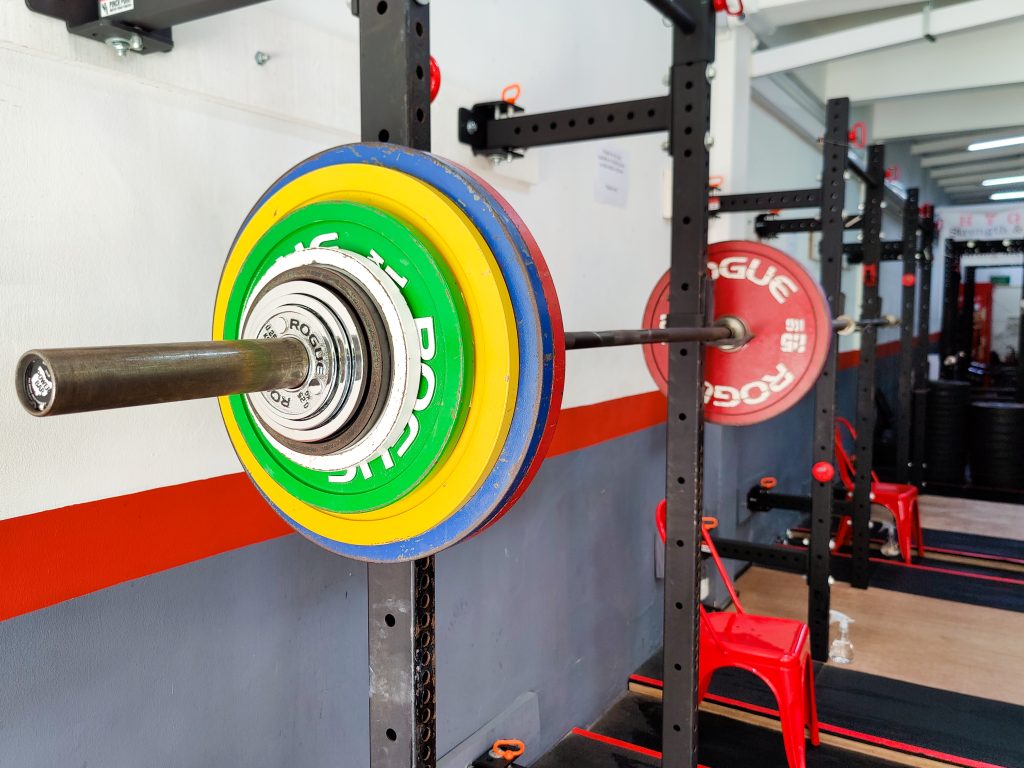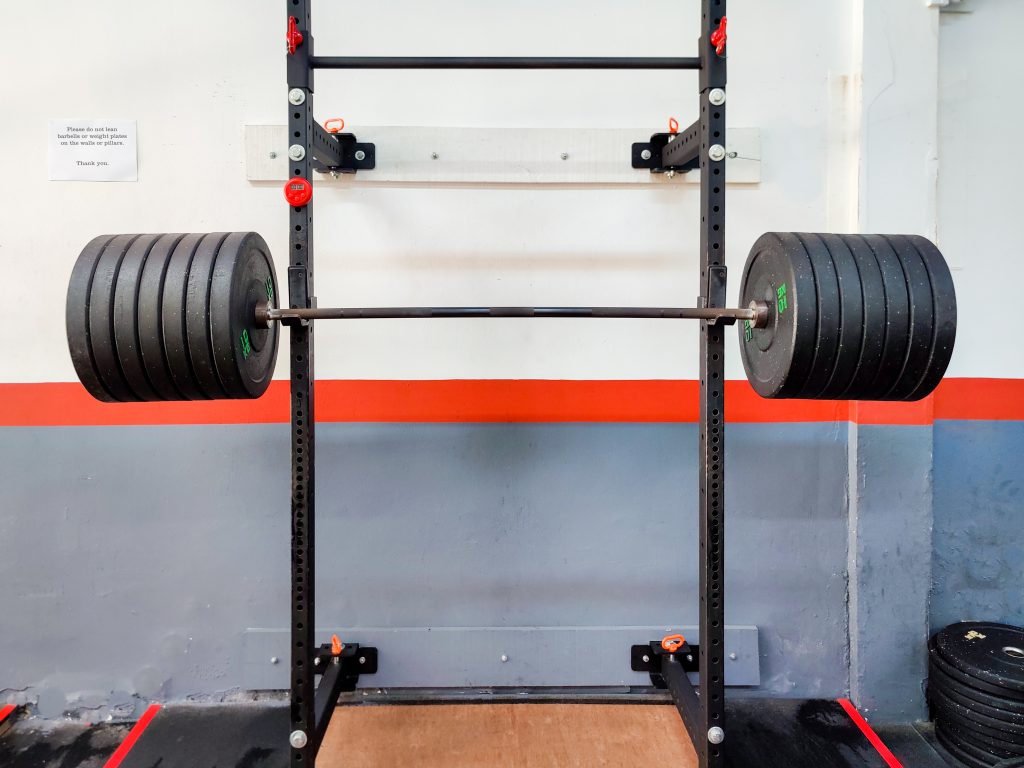
Look around your gym and you can sort of tell who’s a new lifter by the way they load the bar. Lifters that are new to barbell training often have a telltale hesitation – before loading plates, they’ll pause by the bar and seem to stare into space for a bit before starting to load the bar. Why? More often than not, they’re doing plate maths in their head. Sometimes, you can see them counting with their fingers. Sometimes, they’ll even break out the calculator app on their phones.
And chances are, they may make a couple of errors along the way before getting it right. When you first started out, have you ever had the experience whereby you thought you loaded a certain weight, but somehow the bar feels lighter or heavier than expected. So you rack the bar, re-count the plates… and realise you calculated wrong.
At our gym, if our coaches notice that you’ve loaded the wrong weights, we won’t tell you what to put on the bar but rather ask you questions, to guide you along to the right weight. But what if you’re training on your own? You may not even know that you got the wrong weight and that can cause problems to your progress. We’ve seen lifters miss reps and complained that the barbell felt extra heavy that day only to find out that they’ve accidentally loaded an extra 10 kgs.
Barbell maths can be tricky
So what plates should you put on the bar, to get to the weight that you need?
Unlike most gym equipment (machines or dumbbells) that clearly spell out the total weight, barbells require some mental maths. You need to add up the weight of the bar and the various plates to get to the weight you need. And you need to do this every time you change weights.
The “difference and divide” method is confusing
This is what most people will intuitively do. Say you need to get to 32.5 kg. If the barbell itself is 20 kg, you subtract that from 32.5 kg to get 12.5 kg. Then you divide that by two to get 6.25 kg, which is the weight of the plates to add to each side.
(Note: when we talk about weight, it is ALWAYS the weight of all plates (on both sides) plus the barbell. It’s not just the weight of the plates per side or the total weight of plates.)
So far, this is easy. But then, what plates will make up 6.25 kg? This part can get confusing – you can continue the process above, but there can be many permutations. 1 x 5 kg plate and 1 x 1.25 kg plate can get you there. But so can 2 x 2.5 kgs plates and 1 x 1.25 kg plate.
Mathematically, subtracting and dividing makes sense. But in the long run, it’s not the easiest or most practical way.
Let’s see how we can do this better.
First, know the weights of the bars and plates at your gym
At most gyms, the only barbell that they’ll have is 20kgs. At Hygieia, we have 20kg, 15kg, 7.5kg and 5kg barbells.
As for plates, most gyms will have the following weights: 20 kg, 15 kg, 10 kg, 5 kg, 2.5 kg and 1.25 kg.
Additionally, in our gym, you’ll also find 25 kg plates and microplates of 1 kg, 0.75 kg, 0.5 kg and 0.25 kg. You won’t find these microplates at most gyms, but they are essential when it comes to microloading.
Once you’re familiar with the available barbells and weights, then you can start calculating.
Start with the heaviest plate and add up the weights
The rule of thumb is to use the heaviest available plates first and work your way down. You do this by adding up the weight of the bar and as many of the heaviest plates as you can, until it’s just under or equals you’re the weight you want. Then, go to the next heaviest plate, and repeat the addition until you get to your working weight.
Let’s say you want to get to 32.5 kg. Your bar is 20 kg.
Can you use the 25 kg plate? – Nope, because you’ll get to 70 kg.
(Remember, you must add plates on both sides; think of them as pairs. So multiply 25 kg by 2, and add the 20 kg bar, for a total of 70 kg.)
This is still pretty far off. Let’s continue to iterate.
Can you use the 20 kg plate? – Nope, because you’ll get to 60 kg.
Can you use the 15 kg plate? – Nope, because you’ll get to 50 kg.
Can you use the 10 kg plate? – Nope, because you’ll get to 40 kg.
Can you use the 5 kg plate? – Yes, and you’ll get to 30 kg.
So now you’re at 30 kg, which is close.
Next, can you use the 2.5 kg plate? – Nope, because you’ll get to 35 kg.
Next, can you use the 1.25 kg plate? – Yes, and you’ll get to 32.5 kg.
Done!
So for 32.5 kg, you’ll use 1 pair each of the 5 kg and 1.25 kg plates.
How about heavier loads? The same rule applies, just that you should repeat adding the heaviest plate until it doesn’t work anymore, instead continuing with the next heaviest and working your way down.
Let’s say you want to get to 160 kg, and your bar is 20 kg.
Can you use the 25 kg plate? – Yes, and you’ll get to 70 kg.
Can you use the 25 kg plate again? – Yes, and you’ll get to 120 kg.
Can you use the 25 kg plate one more time? – Nope, because you’ll get to 170 kg.
(This exceeds your total, so go to the next heaviest instead.)
Can you use the 20 kg plate? – Yes, you’ll get to your goal of 160 kg.
Done!
So for 160 kg, you’ll use 2 pairs of 25 kg plates, and 1 pair of 20 kg plates.
By the way, using the heaviest plates possible isn’t just about efficient maths. It’s also gym etiquette – by using the heaviest, you use the least number of plates possible.
While you can always load 7 pairs of 10 kg plates on your 20 kg barbell to get to 160 kg, you’ll be known as the asshole who hogs all the plates.

The math comes naturally after a while
While barbell maths can be a bit tedious at first, you’ll get better at it.
And as you get more familiar, you’ll find that you’ve memorised some “milestone numbers”. These are mental shortcuts. For example, 2 x 25 kg plates will get you to 70 kg, 4 x 20 kg plates will get you to 100 kg, etc.
In fact, you’ll easily recognise most common combinations of plate numbers. Over time, you’ll get faster and more accurate, to the point where it becomes second nature – you won’t even have to think. You’ll just simply identify the working weight, and instinctively know what plates to add.
How about calculators and apps?
Sure, there’re tons out there and nothing’s stopping you from using them. But why rely on external help, when it’s much more beneficial to understand the loading process?
All calculators have limitations. Let’s look at warm-up calculators. You can punch in numbers, and they’ll output weights to load and reps to do. But until you actually understand what goes on behind the calculation, you won’t have enough knowledge of the warm-up process. You won’t be able to tweak it to suit you better, or make changes to adjust to circumstances.
For example, if you’re going for a press PR, your last warm-up weight should be pretty close to the weight that you’re trying to hit. Compare that to the increment between your last warm-up and working weight on your squat on a regular training day. If you simply follow the recommended warm-up weight/reps on these calculators, you’ll quickly realise that these 2 events are totally different situations, which require different approaches to warm-ups. Calculators don’t see this.
Simply put: if you understand why, you can make better training decisions.
Understanding gives you the confidence to train on your own
There’s a list of basic things that we want all our clients to understand. These include how to warm up, how to load the plates, and how to set up your rack height/bench/safety bar.
Why do these matter? Because if you get these fundamentals right, you’ll gain confidence in the gym. And confidence leads to independence.
Maybe you have to travel or spend time overseas. If you can confidently train by yourself while you’re away, that’s awesome. Even if you change gyms, or decide to carry on training on your own, we’ll be glad that you can because we know that we did our job as coaches. No matter where you go, we’re proud knowing that you’re armed with useful, essential knowledge that makes you a better lifter.
Our coaching goal: not only how, but also why
If you’ve been coached by us, you’ll know that we explain things in bits and bobs, as and when they’re relevant. In general, we’ll always explain how you can do a lift. If our clients are curious to know more, we’ll dive into more detail, like why it’s done in a particular way. Ditto for programming, warm-ups, recovery and everything else.
As coaches, we see ourselves as advisors and teachers. We don’t want you to be passive and blindly follow everything we say. We strongly believe that you should learn and understand the ‘how’s and ‘whys’ of training.
By understanding the concepts behind your actions, you’ll benefit more and set yourself up for better progress in the long run.

